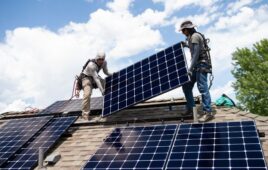
Editor’s Note: This article by Glenna Wiseman is Part 3 of a three-part look at the importance of solar PV operations-and-maintenance. The series covers the evolving O&M market prior to the first trade event solely dedicated to this topic in the United States, Solar O&M North America March 25 -26 in San Francisco. The article experts will share more insights as panelists at this upcoming event.
Editor’s Note: This article by Glenna Wiseman is Part 3 of a three-part look at the importance of solar PV operations-and-maintenance. The series covers the evolving O&M market prior to the first trade event solely dedicated to this topic in the United States, Solar O&M North America March 25 -26 in San Francisco. Our article experts will share more insights as panelists at this upcoming event.
By Glenna Wiseman, Solar Power World Contributor
Solar operations and maintenance (O&M) is vital to the successful return on investment for distributed generation as well as utility scale solar. Here in the third part of our series on solar O&M we look at five considerations shaping these strategies for American residential and commercial photovoltaic installations.
Our Experts
The Residential Perspective
 Greg Sellers (Sellers) is vice president of field operations at Clean Power Finance (CPF). He is solar industry veteran who has led industry-wide efforts to increase quality and expedite the development of residential solar installations. Greg pioneered the development of residential solar inspections as the founder of Burnham Energy, a company that inspected over 2,500 systems in 31 states. He has spoken at major solar conferences and is a founding member of SolarTech, an industry consortium seeking to resolve barriers to the adoption of solar energy.
Greg Sellers (Sellers) is vice president of field operations at Clean Power Finance (CPF). He is solar industry veteran who has led industry-wide efforts to increase quality and expedite the development of residential solar installations. Greg pioneered the development of residential solar inspections as the founder of Burnham Energy, a company that inspected over 2,500 systems in 31 states. He has spoken at major solar conferences and is a founding member of SolarTech, an industry consortium seeking to resolve barriers to the adoption of solar energy.
The Commercial Perspective
 Joe Kastner (Kastner) is the vice president of operations for Radian Generation, provider of ongoing solar asset management and consulting services to investors, lenders and owners of projects. The company’s customers include utilities, private equity/hedge funds, developers, and publicly traded vehicles that are looking for more predictability and improved operating performance of their assets. Joe has over 12 years of technical management experience in solar PV project development, construction and operation.
Joe Kastner (Kastner) is the vice president of operations for Radian Generation, provider of ongoing solar asset management and consulting services to investors, lenders and owners of projects. The company’s customers include utilities, private equity/hedge funds, developers, and publicly traded vehicles that are looking for more predictability and improved operating performance of their assets. Joe has over 12 years of technical management experience in solar PV project development, construction and operation.
1. Residential versus Commercial: What is the primary difference you see between residential and commercial solar O&M?
Kastner: At the small end of commercial solar scale they can be very similar. As project sizes get bigger, the primary difference is the preventative maintenance strategy. Residential projects individually have a difficult time absorbing truck rolls and robust preventative programs can be hard to justify. As a result the strategy becomes largely reactive and response is based on a combination of critical mass and customer complaints. Commercial projects typically have revenue streams that justify a stronger preventative maintenance strategy, but even there we see owners remaining too reliant on reactive maintenance. A strong preventative and predictive program for larger projects should be the natural evolution of the industry. The challenge is bringing a beneficial strategy like this to smaller projects.
2. Primary Solar O&M Challenge: What is your main challenge with O&M activities and how do you meet it?
Sellers: I’d say the main challenge for O&M activities is actually system installation. Installation is the single biggest factor in determining how much maintenance a system will need. Minor install oversights can become major maintenance headaches down the road; consistent best practices for installation will be crucial in the coming years as inexperienced new players enter the market and existing players work to ramp their install rate. Standardization is also a prerequisite for large-scale securitization: investors won’t buy into solar unless they can be sure of the quality of the installation. That’s why CPF is working with NREL and others to propose standards for residential solar installation best practices.
Kastner: The main challenge with asset management including O&M is the Federal ITC. The resultant financial structuring becomes focused on upfront fees and the budgeting for operations gets lost in the process since the size of the operations budget has a direct impact on the upfront fee. As a result, the challenge becomes providing proper asset management without an adequate operations budget.
3. Solar O&M Fulfillment: How do you fulfill solar O&M activities? Do you use in-house or out-sourced resources and why?
Sellers: As a white label solar financial services and technology company, CPF’s aim is to promote our channel partners’ brands so they can own the homeowner relationship and, more importantly, the referrals. The installers transact with the homeowners and we transact with the installers and the project finance providers. Therefore, the homeowner’s primary relationship will be with installer. CPF provides resources to both the homeowner and installer to support that relationship. CPF is most likely to be the first to find problems with systems because we monitor them on a daily basis. Once we identify a problem, we work with the installer to fix it; usually, the installer goes out and answers O&M calls. In the event an installer can’t service the system promptly or correctly, CPF contracts with qualified third parties to fix the system. The set-up can be flexible depending on how the solar installer operates. At the end of the day, we work with channel partners to make sure investor requirements are met and homeowners’ systems are producing the power they should.
Kastner: Radian Generation provides a broad range of asset management services and works with partners with respect to boots-on-the-ground O&M activities. The projects we manage typically have existing O&M contracts in place or have O&M structured through the EPC/warranty provider.
4. Solar O&M Budget Considerations: What are the primary factors in budgeting solar O&M activities?
Sellers: The challenge in budgeting for O&M is that you have to project performance so far into the future with relatively little information in the present. Component replacement costs are the most significant and quantifiable of budget considerations: the balance of budgeting costs is based on projected service calls. We have developed a pretty good idea of average short-term maintenance requirements by observing system performance to date, but there is little reliable data on system performance in the later years of a system’s life. Given that, we try to be conservative in budgeting to account for all possibilities.
Kastner: Project revenue, size, location (geography and climate), proximity to other projects, design, and equipment.
5. Solar O&M Return on Investment: How do you measure the financial return on investment for your solar O&M activities?
Sellers: CPF’s goal is to maintain the overall performance of the systems we manage above expectations while minimizing service calls. To date we have had good success meeting those goals.
Kastner: In general we like to take the long-view and look at both risk and return with respect to these activities. In our view the stable internal rate of return (IRR) owners can achieve over the long-term with proper asset management and preventative maintenance programs is preferable to the unstable IRR associated with a reactive strategy.
Want more? Try these articles:
Solar Is NOT Maintenance Free: The Growing U.S. Solar O&M Market
5 Factors Shaping the Solar O&M Market in the U.S. and Europe
Webinar: Don’t Settle For Dirty Panels — O&M Can Save The Day





Tell Us What You Think!